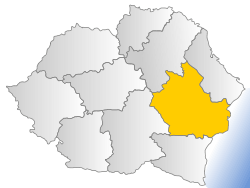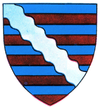Ținutul Dunării
| Ținutul Dunării Ținutul Dunărea de Jos | ||
|---|---|---|
| Land (Ținut) | ||
| ||
 | ||
| Country |
| |
| Former counties included | Brăila County, Cahul County, Covurlui County, Fălciu County, Ismail County, Putna County, Râmnicu Sărat County, Tecuci County, Tulcea County, Tutova County | |
| Historic region | Dobruja (Northern Dobruja), Moldavia (Bessarabia, Budjak) | |
| Capital city (Reședință de ținut) | Galați | |
| Established | The administrative reform of 1938 | |
| Cesed to exist | Territorial loss and new administrative law (26–28 June 1940) | |
| Government | ||
| • Type | Rezident Regal | |
| Time zone | EET (UTC+2) | |
| • Summer (DST) | EEST (UTC+3) | |
Ținutul Dunării (or Ținutul Dunărea de Jos) was one of the ten Romanian ținuturi ("lands") founded in 1938, after King Carol II initiated an institutional reform by modifying the 1923 Constitution and the law of territorial administration. Named after the Danube River and extending over historical areas of Moldavia (into Moldavia-proper, as well as Budjak and Bessarabia), Northern Dobruja (with the Danube Delta), and an area of Wallachia around Brăila. Its capital was the city of Galați. Ținutul Dunării ceased to exist following the territorial losses of Romania and the king's abdication in 1940.
Coat of arms
The Coat of Arms consists of ten bars, five of azure and five of murrey, representing the former ten counties (județe) of Greater Romania (71 in total) which it included. Over the bars there is an argent bend, of wavy shape, reminding of the Danube.
Former counties incorporated
After the 1938 Administrative and Constitutional Reform, the older 71 counties lost their authority.
- Brăila County
- Cahul County
- Covurlui County
- Fălciu County
- Ismail County
- Putna County
- Râmnicu Sărat County
- Tecuci County
- Tulcea County
- Tutova County
See also
External links
| ||||||||
